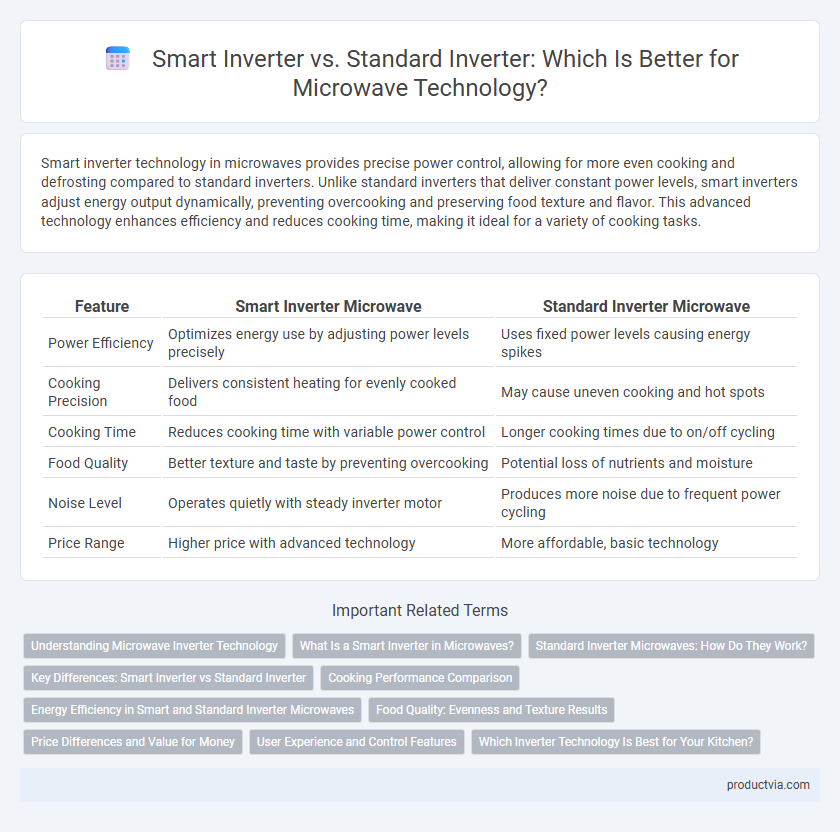Smart inverter technology in microwaves provides precise power control, allowing for more even cooking and defrosting compared to standard inverters. Unlike standard inverters that deliver constant power levels, smart inverters adjust energy output dynamically, preventing overcooking and preserving food texture and flavor. This advanced technology enhances efficiency and reduces cooking time, making it ideal for a variety of cooking tasks.
Table of Comparison
| Feature | Smart Inverter Microwave | Standard Inverter Microwave |
|---|---|---|
| Power Efficiency | Optimizes energy use by adjusting power levels precisely | Uses fixed power levels causing energy spikes |
| Cooking Precision | Delivers consistent heating for evenly cooked food | May cause uneven cooking and hot spots |
| Cooking Time | Reduces cooking time with variable power control | Longer cooking times due to on/off cycling |
| Food Quality | Better texture and taste by preventing overcooking | Potential loss of nutrients and moisture |
| Noise Level | Operates quietly with steady inverter motor | Produces more noise due to frequent power cycling |
| Price Range | Higher price with advanced technology | More affordable, basic technology |
Understanding Microwave Inverter Technology
Smart inverter microwave technology uses advanced microprocessor controls to adjust power levels precisely, ensuring more efficient and even cooking compared to standard inverters. Unlike standard inverters that deliver a constant power output, smart inverters modulate the microwave's energy based on the food's requirements, reducing overheating and energy consumption. This results in enhanced cooking performance, improved food texture, and greater energy savings in microwave appliances.
What Is a Smart Inverter in Microwaves?
A smart inverter in microwaves uses advanced microprocessor technology to deliver consistent power levels, enabling precise cooking by adjusting energy output based on food type and weight. Unlike standard inverters that operate at fixed power levels, smart inverters optimize energy efficiency and prevent overcooking by providing variable power settings throughout the cooking process. This results in faster, more evenly cooked meals with improved texture and taste, enhancing overall microwave performance.
Standard Inverter Microwaves: How Do They Work?
Standard inverter microwaves operate by cycling the magnetron on and off at full power to achieve the desired cooking level, resulting in uneven heating and temperature fluctuations. Instead of delivering continuous power, these models use a traditional transformer and capacitor system to regulate power output in discrete intervals. This operation method makes standard inverter microwaves less efficient and less precise compared to smart inverter models that modulate power seamlessly.
Key Differences: Smart Inverter vs Standard Inverter
Smart inverter microwave technology offers precise power control by adjusting microwave energy levels according to the food's requirements, resulting in more even cooking and energy efficiency. Standard inverter microwaves operate at fixed power levels, often causing uneven heating and longer cooking times. The smart inverter's ability to modulate power enhances food texture and retains nutrients better compared to the on-off cycling of standard inverter models.
Cooking Performance Comparison
Smart inverter microwaves deliver precise power control, enabling consistent and even cooking by adjusting energy output to the food's needs, which prevents overcooking or uneven heating commonly observed in standard inverter models. Standard inverter microwaves provide a simpler power regulation, resulting in less uniform cooking and potential cold spots or overheating. The advanced modulation of smart inverter technology enhances cooking accuracy and texture, making it superior for delicate or complex dishes compared to traditional inverter microwaves.
Energy Efficiency in Smart and Standard Inverter Microwaves
Smart inverter microwaves utilize advanced power control technology that adjusts energy output continuously, resulting in up to 30% higher energy efficiency compared to standard inverter models. Standard inverter microwaves operate on fixed power levels, leading to greater energy consumption and uneven cooking performance. Improved energy efficiency in smart inverter microwaves contributes to reduced electricity bills and environmental impact through optimized power usage during cooking cycles.
Food Quality: Evenness and Texture Results
Smart inverter technology in microwaves delivers superior food quality by providing consistent and precise power levels, ensuring even cooking and improved texture. Standard inverters often produce uneven heat distribution, leading to overcooked edges and undercooked centers. Enhanced power modulation in smart inverter microwaves preserves moisture and texture, resulting in better-tasting and evenly heated meals.
Price Differences and Value for Money
Smart inverter microwaves typically cost 20-30% more than standard inverter models due to advanced energy efficiency and precise power control technology. The higher initial price is offset by significant energy savings and better cooking performance, resulting in enhanced value for money over the appliance's lifespan. Standard inverter microwaves offer a lower upfront cost but may lack the efficiency and consistent cooking results provided by smart inverters.
User Experience and Control Features
Smart inverter microwaves offer precise power control and consistent cooking results, enhancing user experience by reducing overcooking and uneven heating common in standard inverters. These advanced models feature intuitive control panels with customizable settings, allowing users to program cooking sequences and adjust power levels seamlessly. Enhanced sensor technology in smart inverters provides real-time feedback, improving cooking accuracy and convenience compared to traditional inverter microwaves.
Which Inverter Technology Is Best for Your Kitchen?
Smart inverter technology in microwaves offers precise temperature control and consistent cooking by modulating power levels, resulting in evenly cooked food and energy efficiency. Standard inverter microwaves provide basic power regulation but often lead to uneven heating and longer cooking times due to less accurate energy distribution. Choosing a smart inverter microwave enhances cooking flexibility, saves energy, and improves overall kitchen performance compared to standard inverter models.
Smart inverter vs Standard inverter for microwave technology Infographic

 productvia.com
productvia.com